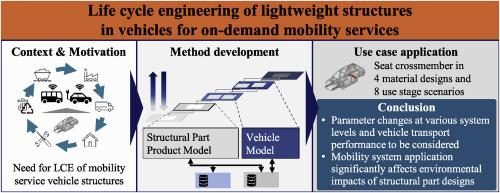按需移动服务车辆轻量化结构的生命周期工程
IF 6.5
Q2 ENGINEERING, ENVIRONMENTAL
引用次数: 0
摘要
为了减少与运输有关的环境影响,正在开发创新的移动系统方法,如按需服务。这些可能包括在机动个人运输中与私人拥有的汽车在其特性和应用概况方面不同的运营车辆。汽车轻量化结构的生命周期评价和生命周期工程研究主要局限于这些私家车和气候变化的影响范畴。本文提出了一种基于生命周期评估的车辆轻量化结构工程方法,用于各种移动系统应用,包括按需移动服务。该方法能够在考虑上游产品、组件、子系统、车辆和移动系统级别参数变化的情况下,对不同移动系统应用中的轻量化结构进行整体生命周期评估,并将结果整合到工程活动中。案例研究表明,轻量化结构的车辆和移动系统应用可以显著影响其环境影响和生态优选产品设计的选择。与用于机动个人运输的私人拥有车辆相比,在按需移动服务车辆上的应用可能导致绝对使用阶段能源需求和环境影响的增加。然而,根据所提供的运输性能,按需移动服务车辆结构部件的生命周期环境影响可能低于机动个人运输车辆。本文以系统的和定量的结果为改进移动系统应用中轻量化结构生命周期工程活动的决策作出贡献。本文章由计算机程序翻译,如有差异,请以英文原文为准。

Life cycle engineering of lightweight structures in vehicles for on-demand mobility services
To reduce transport-related environmental impacts, innovative mobility system approaches such as on-demand services are being developed. These can include operating vehicles that differ regarding their characteristics and application profile from privately owned cars in motorized individual transport. Studies on life cycle assessment and life cycle engineering of vehicle lightweight structures are mainly limited to these privately owned cars and the impact category of climate change. In this paper, a method for life cycle assessment-based engineering of lightweight structures in vehicles for various mobility system applications, including on-demand mobility services, is developed. The method enables the holistic life cycle assessment of lightweight structures in different mobility system applications considering parameter changes at the upstream products, component, subsystem, vehicle and mobility system levels, as well as the integration of results into engineering activities. A case study is used to show that the vehicle and mobility system application of lightweight structures can significantly influence their environmental impacts and the selection of ecologically preferable product designs. The application in vehicles for on-demand mobility services can lead to an increase in absolute use stage energy demand and environmental impacts compared to applications in privately owned vehicles for motorized individual transport. However, normalized to the transport performance provided, the lifecycle environmental impacts of structural components in vehicles for on-demand mobility services can be lower than in vehicles for motorized individual transport. The paper contributes methodically and with quantitative results to improved decision making in life cycle engineering activities for lightweight structures in mobility system applications.
求助全文
通过发布文献求助,成功后即可免费获取论文全文。
去求助
来源期刊

Cleaner Engineering and Technology
Engineering-Engineering (miscellaneous)
CiteScore
9.80
自引率
0.00%
发文量
218
审稿时长
21 weeks
 求助内容:
求助内容: 应助结果提醒方式:
应助结果提醒方式:


